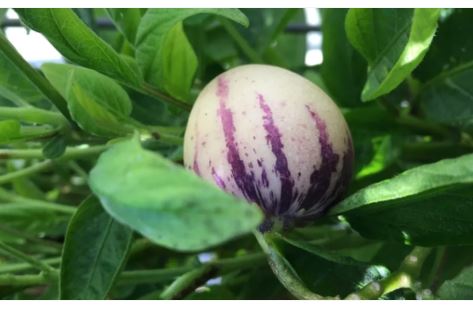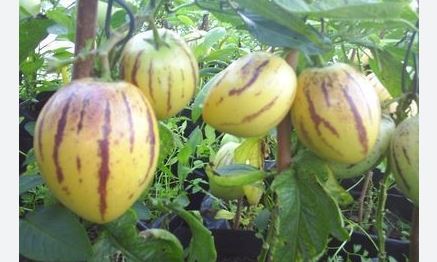
Pepinos, scientifically classified as Solanum muricatum, belong to the Solanaceae family, commonly known as the nightshade family, which includes relatives like tomatoes (Solanum lycopersicum), eggplants (Solanum melongena), and potatoes (Solanum tuberosum). This evergreen shrub produces a berry—technically a fruit, not a vegetable—despite its cucumber-like name in Spanish (“pepino” means cucumber). It’s a diploid species (2n = 24) and is typically propagated via cuttings rather than seeds, though fertile seeds can produce offspring. Its close kinship with other nightshades ties it to a rich lineage of edible crops.
Pepinos are native to the temperate Andean highlands of South America, spanning modern-day Colombia, Peru, and Chile. While their exact wild ancestor remains unknown—since they’re not found in the wild—evidence suggests they were domesticated in this region long before European contact. The fruit’s origins are tied to pre-Columbian agriculture, with the Moche Valley in Peru noted for its early cultivation. Unlike many crops, pepinos lack a clear wild progenitor, hinting at a complex domestication process shaped by Andean farmers.
Pepinos have a deep history in Andean culture, predating the Inca Empire, and were documented by Spanish chroniclers in the 16th century as a coastal crop. The Moche people famously depicted them in their art, suggesting both culinary and symbolic value. After European colonization, pepinos remained a regional staple in South America but didn’t spread widely until the 20th century, when New Zealand, Chile, and California began commercial cultivation. Efforts to export them globally have been limited by their delicate nature, though they’ve gained niche popularity in upscale markets in Japan, Europe, and North America.
Pepino fruits vary widely: they can be round, oval, or pear-shaped, typically 5-15 cm long and 300-500 grams in weight. Their skin ripens from green to yellow, orange, or purple, often with purple stripes, and becomes smooth and glossy but tough when mature. The flesh is pale to golden, juicy, and succulent, with a texture akin to a pear or melon, encasing a small seed cavity (seeds are edible but sparse in some cultivars). The flavor blends honeydew melon and cucumber—sweet, mild, and refreshing—earning names like “pepino dulce” (sweet cucumber) or “melon pear.”
Pepinos thrive in USDA Hardiness Zones 9-11, preferring warm, frost-free climates with temperatures above 27°F (-3°C). They can tolerate brief cold snaps but may lose leaves below freezing. Ideal growing conditions mimic their Andean roots: mild days (65-80°F or 18-27°C) and cool nights. In the U.S., they’re cultivated in California and Hawaii, while New Zealand and Chile exploit similar temperate zones. They’re often grown as annuals outside these zones, though they’re perennial by nature.
In their native regions and warm climates, pepinos are available year-round, with peak production from spring to fall (March-November in the Northern Hemisphere). Flowering occurs August-October, with fruit ripening September-November, maturing 30-80 days after pollination. In temperate areas like California, they’re seasonal, while greenhouses extend availability. Their fragility limits long-distance shipping, so fresh pepinos are mostly found near growing regions; otherwise, they’re rare in global markets.
Pepinos shine in fresh preparations due to their mild, sweet flavor and juicy texture. They’re often peeled and eaten as a snack, sliced into fruit salads, or paired with citrus and chili powder in South American recipes. Their melon-like quality suits smoothies, sorbets, and desserts, while some cultivars with higher acidity work in savory salads or salsas. Though less common, they can be cooked—lightly sautéed or added to soups—retaining their delicate taste. Their zero-waste appeal (fully edible when ripe) makes them a versatile, low-prep ingredient.

Cultivation of Pepinos Fruit
Climate Requirements
Pepinos thrive in mild, temperate climates with daytime temperatures of 65-80°F (18-27°C) and cooler nights around 50-60°F (10-15°C). They’re sensitive to frost (below 27°F or -3°C), making them ideal for USDA Zones 9-11, though they can be grown as annuals in cooler zones. High humidity aids growth, but excessive heat above 85°F (29°C) can reduce fruit set.
Soil Preferences
Well-drained, fertile soil is essential, with a pH range of 6.0-7.0. Pepinos prefer loamy or sandy loam soils rich in organic matter—compost or aged manure boosts nutrient levels. Poor drainage leads to root rot, so raised beds or sandy mixes are recommended in heavy clay areas.
Site Selection
Choose a sunny location with at least 6-8 hours of direct sunlight daily, as pepinos are light-demanding for optimal fruiting. Shelter from strong winds is key, as their brittle branches snap easily. In hot climates, partial afternoon shade can prevent heat stress.
Propagation Methods
Pepinos are typically propagated via stem cuttings (6-8 inches long) taken from healthy plants, rooted in moist soil or water with rooting hormone. Seeds are viable but less common due to slow germination (2-4 weeks) and variable offspring traits. Cuttings ensure consistency and faster establishment.
Planting Time
Plant in spring after the last frost, when soil temperatures reach 60°F (15°C), to encourage root growth. In frost-free zones, year-round planting is possible, though spring or late summer aligns with peak fruiting seasons. Space plants 2-3 feet apart to allow for sprawling growth.
Watering Needs
Consistent moisture is critical—water deeply once or twice weekly, providing 1-2 inches (2.5-5 cm) depending on rainfall. Avoid waterlogging; the soil should stay moist but not soggy. Drip irrigation works well, keeping foliage dry to reduce fungal risks.
Fertilization
Apply a balanced fertilizer (e.g., 10-10-10 NPK) at planting, then side-dress with nitrogen-rich compost or 5-10-10 every 4-6 weeks during the growing season. Over-fertilizing with nitrogen can lead to excessive foliage at the expense of fruit; phosphorus and potassium support flowering and fruit development.
Support and Pruning
Pepinos grow as sprawling shrubs or vines, reaching 3-6 feet tall and wide. Staking, trellising, or caging prevents branches from breaking under fruit weight and keeps fruit off the ground. Prune lightly to remove dead or crowded stems, improving air circulation and light penetration.
Pollination
Pepinos are self-pollinating, with small, purple-starred flowers that don’t require insects, though bees can enhance fruit set in outdoor settings. In greenhouses, gentle shaking of plants or hand-pollination with a brush ensures consistent yields, especially if natural pollinators are scarce.
Pest and Disease Management
Common pests include aphids, spider mites, and whiteflies—control with insecticidal soap or neem oil. Diseases like powdery mildew (humid conditions) or root rot (poor drainage) can be prevented with good airflow, dry foliage, and proper watering. Resistant cultivars help in problem areas.
Growth Cycle
From planting, pepinos flower in 60-90 days, with fruit maturing 30-80 days later, depending on cultivar and climate. Perennial in warm zones, they produce for 2-3 years; in colder areas, they’re grown as annuals. Fruiting peaks in late summer to fall (September-November).
Harvesting
Harvest when fruits turn yellow, orange, or purple with softened skin—typically 4-6 months after planting. They should feel slightly firm yet yield to gentle pressure, with a sweet aroma. Cut, don’t pull, to avoid damaging plants; unripe fruits ripen off the vine if picked green.
Post-Harvest Care
Pepinos store at room temperature for 2-4 weeks, or refrigerated at 45-50°F (7-10°C) for up to 2 months, though chilling can dull flavor. Handle gently to avoid bruising, as their thin skin is delicate. In perennial setups, prune plants post-harvest to encourage next season’s growth.